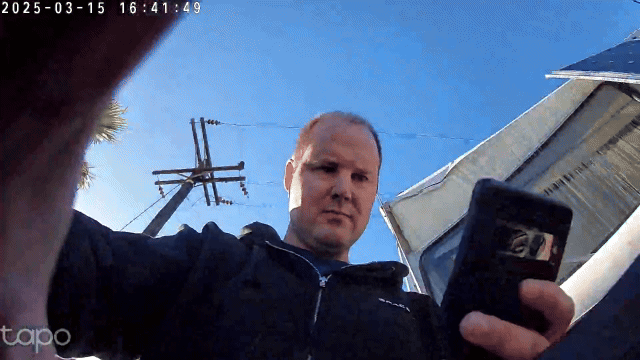First time on the water
First time in the water for Bob! Goals were:
Don’t sink
Test out launching/transport cart
Evaluate weight distribution
Test thruster pod and gather speed/power data
Evaluate rudder size/control authority
Test drive UI
After scouting a few potential locations, we ended up launching from the Marina Del Rey public boat ramp. The 3ft-deep keel and thruster pod made transport and launch a bit tricky; we required a shallow enough ramp to drive the wheeled cart into the water, along with sufficient dock access alongside the boat.
The transport cart worked perfectly! It's a Global Industries workbench frame with pneumatic wheelbarrow wheels mounted on an axle. I installed additional bracing, as we had to remove the left frame member, allowing us to roll the cart directly into the water and slide the boat out smoothly. Everything also fit nicely into the trailer.
With Starlink running the entire time, I remotely accessed Bob on my phone to view live video footage as we drove along the coast.
Spotted someone with a much cooler rig than ours at the docks.
Hanging out with the guys.
A major concern was whether the Cubemars DW20 thruster pod would have enough power for the significantly draggier Hull #2. Due to time constraints, we opted not to create a custom fiberglass hull for the second build, instead using an off-the-shelf SoloSkiff micro skiff. Essentially a 14ft rotomolded boat/kayak hybrid, it's much tougher and accommodates larger solar panels and batteries. However, it's less hydrodynamic, reducing top speed. Whether the additional 100 watts of solar offsets this is still unknown.
Results were surprisingly good! We averaged a cruising speed of 2.3 knots at medium thruster power (75 watts). Remember, power consumption (watts) scales with velocity squared, so slower cruising is beneficial. We'll collect solar energy for roughly 5 hours each day and distribute usage over the full 24-hour cycle. At that speed, our journey would take approximately 394 days without any current assistance. Testing within the narrow 1000ft marina channel limited how far we could cruise, and no one felt comfortable pushing it out into the main waterway.
Our chase kayak stayed busy! We may have rammed into her a few times. 300lb of boat is a bit scary when it's coming at you at 5knots. I love the little face that the camera portholes gives it.
It quickly became clear that our rudder was significantly undersized. Initial estimates based on hull area-to-rudder surface area ratios proved inadequate, resulting in insufficient control authority against the wind. The rudder actuator swings from -35° to 35°, driven by a pushrod stepper motor. That part of the system worked well, though we needed some minor tweaking to the hardstop homing routine.
Due to limited rudder effectiveness, we operated manually rather than using waypoint autopilot, effectively driving the boat in first-person view. I developed a UI with split-screen forward video feed and rudder/power controls. Video feeds were from Frigate (docker container) and wifi Tapo cameras. The UI, hosted via Flask/Python in a Docker container, sends commands through a Redis pub/sub connection to the main Docker container handling physical IO. The funniest failure occurred when reversing the propeller RPMs caused the UI to crash—turns out I hadn't handled negative RPMs properly. Driving around further revealed a need for hotkey buttons to quickly execute maneuvers like max port/starboard turns and emergency propeller stop.
Aside from that, software performance was pretty good, with 14 Docker containers running seamlessly. Starlink was flawless, maintaining wifi connections up to 1000 feet away. Data buffered via Telegraf was stored on a remote server at home.
Solar and battery performance was also good. Our 400W solar panels peaked at 290 watts, not unexpected due to the early March sun angle at Los Angeles latitudes.
Overall, a major success for our first outing:
Didn't sink
Launch cart effective
Propulsion successful (up to 7 knots)
Rudder needs resizing
Fun for everyone!
Out-of-water testing the next weekend:
On the to-do list is refactoring telemetry logging code. Currently, a single-threaded loop sequentially retrieves data from sensors (Odrive, GPS, IMU, etc.) and pushes it to Redis, then InfluxDB. Moving each sensor to separate threads or using async would improve update rates, especially critical for high-frequency data like propeller metrics, while maintaining lower update frequencies for sensors like the solar MPPT controller.
Next time, pending rudder adjustments, we'll test waypoint tracking autopilot. The new UI allows easy waypoint editing via a waypoints.json file. Navigation calculates target bearings from GPS data, and our 3-axis magnetometer ensures accurate heading even without GPS motion. PID controllers will manage rudder angle based on bearing error. I've also built a GPS simulator for virtual testing, which performs extremely well in simulations. As far as Bob knows, he's been cruising the same loop around the marine for the last 8 days 😂
While awaiting the next outing, I resolved the thruster issue experienced during our Marina trip. We had unusual problems at higher power levels, limiting motor performance to about 70 watts. After troubleshooting, I found an overlooked "inverter soft_max_current" setting restricting total power, despite correctly configuring motor parameters. The ODrive documentation is incredibly thorough in some place and a little bit lacking in others. Eventually got it figured out by running the motor in a bucket, allowing me to push it to arbitrary power levels without worrying about running into the Coast Guard boats in the Marina.
The rudder extension plate, laser-cut stainless steel from SendCutSend, has already shipped and will be TIG welded onto the existing rudder on Monday.
The DIY underwater camera works! I'm determined to catch some shark footage . Next steps are to bore a hole through the hull and mount it,
Our next sea trial in approximately three weeks will involve a more serious shakedown. We plan to rent a sailboat to tow it into open waters, aiming for 5-10 miles of testing. If everything goes smoothly, we’ll be on track for a mid-April launch party!














